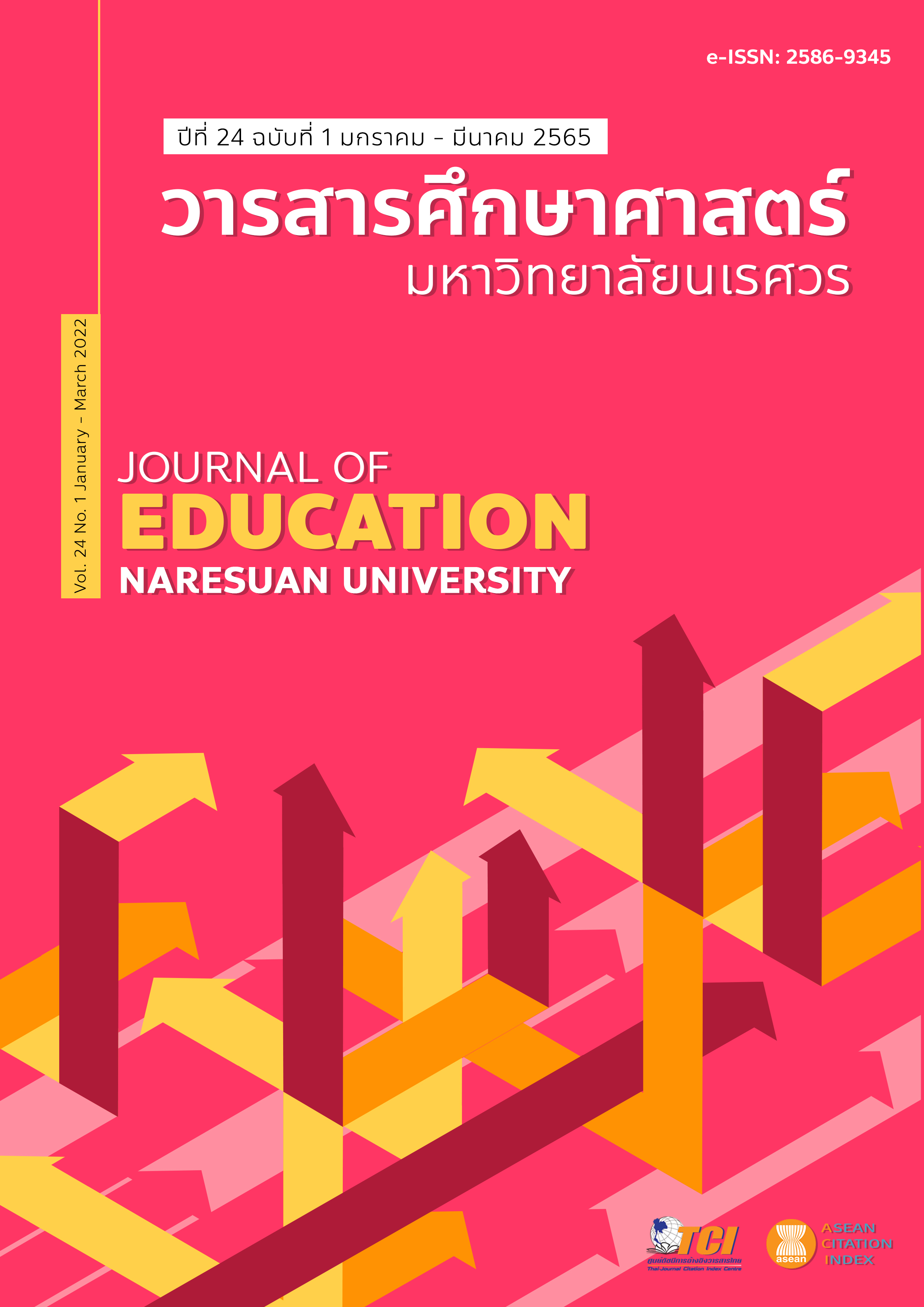การแกะรอยเส้นทางการเรียนรู้ในการให้เหตุผลเชิงวิทยาศาสตร์ของนักเรียนชั้นมัธยมศึกษาปีที่ 5 ที่เรียนด้วยการจัดการเรียนรู้แบบปรับเหมาะในรายวิชาชีววิทยา TRACKING GRADE 11 STUDENTS’ LEARNING PATHWAYS OF SCIENTIFIC REASONING THROUGH ADAPTIVE INSTRUCTION IN BIOLOGY
Main Article Content
บทคัดย่อ
งานวิจัยนี้มีเป้าหมายเพื่อค้นหาเส้นทางการเรียนรู้ในการให้เหตุผลเชิงวิทยาศาสตร์ของนักเรียนชั้นมัธยมศึกษาปีที่ 5 ที่เรียนด้วยการจัดการเรียนรู้แบบปรับเหมาะ จำนวน 38 คน เก็บรวบรวมข้อมูลโดยใช้แบบวัดความสามารถในการให้เหตุผลเชิงวิทยาศาสตร์ ซึ่งเป็นข้อคำถามปลายเปิด ครอบคลุมการให้เหตุผลแบบนิรนัย ประกอบด้วยการสร้างสมมุติฐานที่เป็นไปได้ การระบุและควบคุมตัวแปร และการสร้างข้อสรุปจากการทดลอง และการให้เหตุผลแบบอุปนัย ประกอบด้วยการสรุปความทั่วไปจากการค้นหารูปแบบ การอุปมาอุปไมย และการให้เหตุผลโดยการกำจัดปัจจัยแทรกซ้อน จากนั้นใช้การวิเคราะห์เชิงเนื้อหาเพื่อระบุเส้นทางการเรียนรู้ของนักเรียน ผลการวิจัย พบว่า นักเรียนมีเส้นทางการเรียนรู้ของการให้เหตุผลเชิงวิทยาศาสตร์ 3 เส้นทาง โดยทั้ง 3 เส้นทาง มีจุดเริ่มต้นเหมือนกันในส่วนการให้เหตุผลแบบนิรนัยและความสัมพันธ์ของนิรนัยกับอุปนัย คือ การให้เหตุผลโดยการกำจัดปัจจัยแทรกซ้อนจะพัฒนาได้ก็ต่อเมื่อนักเรียนมีความสามารถในการให้เหตุผลแบบนิรนัย ในองค์ประกอบการระบุและควบคุมตัวแปร และการสร้างสมมติฐานที่เป็นไปได้มาก่อน ส่วนเส้นทางที่ฉีกแยกจากกันจะเริ่มต้นที่การให้เหตุผลแบบอุปนัย ซึ่งผลการวิจัยที่ได้นี้เป็นประโยชน์ต่อการจัดการเรียนการสอนในวิชาชีววิทยาและการออกแบบหลักสูตรเพื่อไต่ระดับของการพัฒนาความสามารถในการให้เหตุผลเชิงวิทยาศาสตร์ของนักเรียน
Article Details

This work is licensed under a Creative Commons Attribution-NonCommercial-NoDerivatives 4.0 International License.
เจ้าของบทความมิได้คัดลอก หรือละเมิดลิขสิทธิ์ของผู้ใด หากเกิดการละเมิดลิขสิทธิ์ ไม่ว่าวิธีใด หรือการฟ้องร้องไม่ว่ากรณีใด ๆ ที่อาจเกิดขึ้นได้ กองบรรณาธิการวารสารศึกษาศาสตร์ ไม่มีส่วนเกี่ยวข้องทั้งสิ้น ให้เป็นสิทธิ์ของเจ้าของบทความที่จะดำเนินการ
References
Adadan, E., Trundle, K. C., & Irving, K. E. (2010). Exploring Grade 11 students' conceptual pathways of the particulate nature of matter in the context of metarepresentational instruction. Journal of Research in Science Teaching, 47(8), 1004-1035.
Akerson, V., & Abd-El-Khalick, F. (2005). How should I know what scientists do? —I am just a kid: Fourth-grade students’ conceptions of nature of science. Journal of Elementary Science Education, 17, 1-11.
Clements, D. H., & Sarama, J. (2004). Learning trajectories in mathematics education. Mathematical Thinking and Learning, 6, 81-89.
Clements, D. H. (2007). Curriculum research: Toward a framework for research-based curricula. Journal for Research in Mathematics Education, 38, 35-70.
Corcoran, T., & Silander, M. (2009). Instruction in high schools: The evidence and the Challenge. The Future of Children, 19(1), 157-183. doi:10.1353/foc.0.0026.
Inoue, N. (2015). Beyond Action: Psychology of action research for mindful educational improvement. New York: Peter Lang Publishing.
Kakosimos. K. E. (2015). Example of a micro-adaptive instruction methodology for the improvement of flipped classrooms and adaptive learning based on advanced blended learning tools improvement of flipped-classrooms and adaptive-learning based on advanced blended-learning tools. Education for Chemical Engineers, 12, 1-11.
Lawson, A. E. (1985). A Review of research on formal reasoning and science teaching. Journal of Research in Science Teaching, 22(7), 569-671.
Lawson, A. E. (2005). What is the role of induction and deduction in reasoning and scientific inquiry? Journal of Research in Science Teaching, 42(6), 716-740.
Lazonder, A. W., & Kamp, E. (2012). Bit by bit or all at once? Splitting up the inquiry task to promote children’s scientific reasoning. Learning and Instruction 22, 458-464.
National Research Council. (2012). A framework for K-12 science education: Practices, crosscutting concepts, and core ideas. Washington, DC: National Academies Press.
Overholser, J. C. (1993). Element of the Socratic method: II inductive reasoning. Psychotherapy, 30(1), 75-85.
Shultz, T. R. (2015). Connectionist models of development. In J. D. Wright (Ed.), International Encyclopedia of the Social & Behavioral Sciences (pp. 1-8). Oxford: Elsevier.
Soncha, N., Ketsing, J., & Kongsema, M. (2018). Grade 10th students’ scientific reasoning in biology. In proceedings of 56th Kasetsart University Annual Conference (pp. 116-125). Bangkok: Kasetsart University. [in Thai]
Suchairut, N., Sawekngam, W., & Tanak, E. (2016). Development of an instructional model based on model-based inquiry and context-based learning approaches to promote scientific reasoning and transfer of learning abilities of lower secondary students. Journal of education Naresuan university, 15(1), 106-113. [in Thai]
Sullivan, P., Mousley, J., & Zevenbergen, R. (2004). Describing elements of mathematics lessons that accommodate diversity in student background. In M. J. Joines and A. Fuglestad. (eds.), The 28th Conference of the International Group for the Psychology of Mathematics Education (pp. 4257-4265). Bergen: Norway.
Suttakun, L., & Ladachart, L. (2014). Fourth grade students’ scientific reasoning. Naresuan University Journal: Science and Technology, 21(3), 107-123. [in Thai]
Vaughn, M. 2015. Adaptive teaching: Reflective practice of two elementary teachers’ visions and adaptations during literacy instruction. Reflective Practice: International and Multidisciplinary Perspectives, 16(1), 43-60.
Zimmerman, C. (2000). The development of scientific reasoning skills. Developmental Review, 20(1), 99-149.

